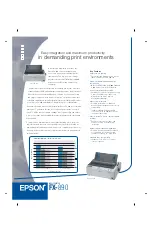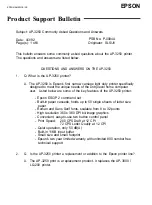
Network Printing
6-9
Unicast, Multicast, and Broadcast
SLP is a unicast and a multicast protocol. This means that messages can be
sent to one agent at a time (unicast) or to all agents (that are listening) at the
same time (multicast). However, a multicast is not a broadcast. In theory,
broadcast messages are “heard” by every node on the network. Multicast
differs from broadcast because multicast messages are only “heard” by the
nodes on the network that have “joined the multicast group.”
For obvious reasons network routers filter almost all broadcast traffic. This
means that broadcasts that are generated on one subnet will not be “routed”
or forwarded to any of the other subnets connected to the router (from the
router’s perspective, a subnet is all machines connected to one of its ports).
Multicasts, on the other hand, are forwarded by routers. Multicast traffic from
a given group is forwarded by routers to all subnets that have at least one
machine that is interested in receiving the multicast for that group.
SMB
SMB (Server Message Block) is a protocol for sharing network resources,
such as files and printers, in a Windows environment. If the Samba server
software is used on Linux or UNIX, services using SMB can be shared.
SMTP
SMTP (Simple Mail Transfer Protocol) is a protocol for sending E-mail.
This protocol was originally used to send E-mail between servers; however,
currently it is also used by client E-mail software that uses POP to send
E-mail to servers.
SMTP Authentication
Specification that adds user authentication functions to SMTP, which is used
for sending E-mail.
When sending E-mail, authentication of the user is performed by the SMTP
server, and the E-mail message is permitted to be sent only if authentication
was successful.
SNMP
SNMP (Simple Network Management Protocol) is actually a set of protocols
for managing complex networks. SNMP works by sending messages to differ-
ent parts of a network. SNMP-compliant devices, called agents, store data
about themselves in Management Information Bases (MIBs) and return this
data to the SNMP requesters.
Summary of Contents for magicolor 1690MF
Page 1: ...magicolor 1690MF Reference Guide A0HF 9573 00A...
Page 23: ...Contents x 22...
Page 24: ...Operation on Mac OS X...
Page 115: ...Troubleshooting 1 92...
Page 116: ...Using LinkMagic...
Page 153: ...Troubleshooting 2 38...
Page 154: ...Using Local Setup Utility LSU...
Page 173: ...Troubleshooting 3 20...
Page 174: ...Printer Utilities...
Page 176: ...Understanding the Network Setting Menu...
Page 181: ...NETWORK SETTING Menu 5 6 USB SETTING COMM SETTING USER SETTING AUTO REDIAL...
Page 188: ...Network Printing...
Page 202: ...Using PageScope Web Connection...
Page 250: ...Configuring the Machine for Administrator Mode 7 49 For FTP Server...
Page 262: ...Configuring the Machine for Administrator Mode 7 61 Fax Configuration...
Page 286: ...Configuring the Machine for Administrator Mode 7 85 IPP...
Page 298: ...Appendix...
Page 303: ...Appendix A 6...
















































